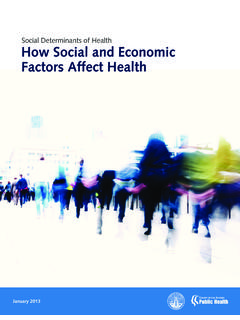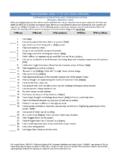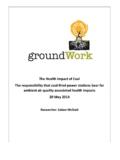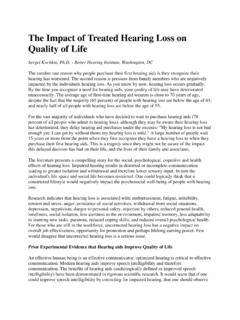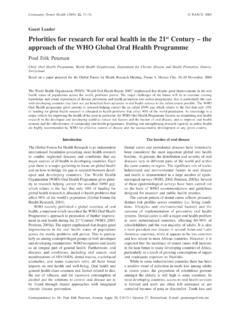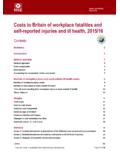Transcription of WHOQOL - WHO | World Health Organization
1 WHO/MSA/MNH/ onlyDistr.: GeneralWHOQOLWHOQOLWHOQOLWHOQOLPROGRAMME ON MENTAL HEALTHDIVISION OF MENTAL Health ANDPREVENTION OF SUBSTANCE ABUSEWORLD Health ORGANIZATIONWORLD Health ORGANIZATIONWORLD Health ORGANIZATIONWORLD Health ORGANIZATIONUUUU World Health Organization 1997 World Health Organization 1997 World Health Organization 1997 World Health Organization 1997 This document is not a formal publication of the World HealthOrganization (WHO), and all rights are reserved by the Organization . The document may, however, be freely reviewed, abstracted, reproducedor translated, in part or in whole, but not for sale or use inconjunction with commercial WHOQOL WHOQOL WHOQOL - MEASURING quality OF life > 1 MEASURING quality OF LIFEMEASURING quality OF LIFEMEASURING quality OF LIFEMEASURING quality OF LIFETHE World Health Organization quality OF LIFETHE World Health Organization quality OF LIFETHE World Health Organization quality OF LIFETHE World Health Organization quality OF LIFEINSTRUMENTSINSTRUMENTSINSTRUMENTSINS TRUMENTS(THE WHOQOL -100 AND THE WHOQOL -BREF)(THE WHOQOL -100 AND THE WHOQOL -BREF)(THE WHOQOL -100 AND THE WHOQOL -BREF)(THE WHOQOL -100 AND THE WHOQOL -BREF)
2 Introducing the WHOQOL instrumentsIntroducing the WHOQOL instrumentsIntroducing the WHOQOL instrumentsIntroducing the WHOQOL instrumentsThe Constitution of the World Health Organization (WHO) defines Health as "Astate of complete physical, mental, and socialwell-being not merely the absence of disease ..". It follows that the measurement of healthand the effects of Health care must include notonly an indication of changes in the frequencyand severity of diseases but also an estimationof well being and this can be assessed bymeasuring the improvement in the quality oflife related to Health care. Although there aregenerally satisfactory ways of measuring thefrequency and severity of diseases this is notthe case in so far as the measurement of wellbeing and quality of life are concerned.
3 WHO, with the aid of 15 collaborating centresaround the World , has therefore developedtwo instruments for measuring quality of life (the WHOQOL -100 and the WHOQOL -BREF), that can be used in a variety ofcultural settings whilst allowing the resultsfrom different populations and countries tobe compared. These instruments have manyuses, including use in medical practice,research, audit, and in policy defines quality of life as individualsZ perception of their position in lifein the context of the culture and value systemsin which they live and in relation to theirgoals, expectations, standards and concerns. It is a broad ranging concept affected in acomplex way by the person's physical Health ,psychological state, level of independence,social relationships, personal beliefs and theirrelationship to salient features of theirenvironment.
4 Strengths of the WHOQOL instrumentsStrengths of the WHOQOL instrumentsStrengths of the WHOQOL instrumentsStrengths of the WHOQOL instrumentsThe WHOQOL instruments were developedcross-culturallyThe WHOQOL -100 was developedsimultaneously in 15 field centres around theworld. The important aspects of quality oflife and ways of asking about quality of lifewere drafted on the basis of statements madeby patients with a range of diseases, by wellpeople and by Health professionals in avariety of cultures. The instrument wasrigorously tested to assess its validity andreliability in each of the field centres and iscurrently being tested to assess responsivenessto change. The WHOQOL -BREF, anabbreviated 26 item version of theWHOQOL-100, was developed using datafrom the field-trial version of the WHOQOL -100.
5 The WHOQOL instruments can be usedin particular cultural settings, but at the sametime results are comparable across cultures. The WHOQOL is now available in over 20different languages and its development inWHOQOLWHOQOLWHOQOLWHOQOL - MEASURING quality OF life > 2further languages is WHOQOL instruments place primaryimportance on the perception of the individualMost assessments in medicine are obtained by examinations by Health workers andlaboratory tests. The WHOQOL instruments, by focusing on individuals' own views oftheir well being, provide a new perspective ondisease. For example, that diabetes involvespoor body regulation of blood glucose is wellunderstood, but the effect of the illness on theperception that individuals have of theirsocial relationships, working capacity, andfinancial status has received little systematicattention.
6 The WHOQOL instruments aretools that will enable this type of research tobe carried out. They not only inquire aboutthe functioning of people with diabetes, acrossa range of areas but also how satisfied thepatients are with their functioning and with effects of development of the WHOQOL -100 The method used to develop the WHOQOL -100 involved considerable research andchecking over several years to ensure that itaccurately measures the issues that areimportant to a person's quality of life , andthat it does so reliably. The institutions whichparticipated in this research now serve asreference centres and can provide technicalsupport to users in their cultural setting (seelater section for contact information). Inreturn for this support, centres request acopy of data collected to be sent to Instruments have different forms fordifferent usesThe core WHOQOL instruments can assess quality of life in a variety of situations andpopulation groups.
7 In addition, modules are being developed to allow more detailedassessments of specific populations ( cancer patients, refugees, the elderly andthose with certain diseases, such of the WHOQOLA dministration of the WHOQOLA dministration of the WHOQOLA dministration of the WHOQOL instrumentsinstrumentsinstrumentsinstrum entsThe national versions of the WHOQOLThe WHOQOL instruments are available in over 20 different languages. The appropriatelanguage version, and permission for using it,can be obtained from the appropriatenational centre, as listed on pages 7-8. Centres may request a copy of data collectedfor collation in a national data set. Amethodology has been developed for newcentres wishing to develop further languageversions of the WHOQOL -100 or theWHOQOL-BREF.)
8 This information can beobtained from The WHOQOL Group,Programme on Mental Health , World HealthOrganisation, CH-1211, Geneva 27,Switzerland. The WHOQOL -BREF is self-administered if respondents have sufficientability: otherwise, interviewer-assisted orinterview-administered forms should be the WHOQOL instrumentsThe WHOQOL -100 produces scores relating to particular facets of quality of life ( feelings, social support, financialresources), scores relating to larger domains( physical, psychological, socialrelationships) and a score relating to overallquality of life and general Health . TheWHOQOL-BREF produces domain scores,but not individual facet scores. Details onscoring are included in manuals availablefrom The WHOQOL Group, Programme onMental Health , World Health Organisation,CH-1211 Geneva 27, Switzerland.
9 Syntaxfiles for checking and cleaning data, and forcomputing facet and domain scores are alsoavailable from The WHOQOL properties of the WHOQOL instrumentsBoth the WHOQOL -100 and the WHOQOL -BREF have been shown to display gooddiscriminant validity, content validity andtest-retest reliability. Their sensitivity toWHOQOL WHOQOL WHOQOL WHOQOL - MEASURING quality OF life > 3change is currently being assessed. Domainscores produced by the WHOQOL -BREF have been shown to correlate at around the WHOQOL -100 domain Uses of the WHOQOL instrumentsThe Uses of the WHOQOL instrumentsThe Uses of the WHOQOL instrumentsThe Uses of the WHOQOL instrumentsIn medical practiceIn clinical practice the WHOQOL instruments may be used with other forms ofassessment, giving valuable information thatcan indicate areas in which a person is mostaffected and help the practitioner in makingthe best choices in patient care.
10 In additionthey may be used to measure change inquality of life over the course of the doctor-patient relationshipBy increasing the physician's understanding of how disease affects a patient's quality oflife, the interaction between patient anddoctor will change and improve. This givesmore meaning and fulfilment to the work ofthe doctor and leads to the patient beingprovided with more comprehensive healthcare. Because a more complete form ofassessment covering different aspects ofpatients' functioning is being carried out,patients themselves may find their Health caremore assessing the effectiveness and relativemerits of different treatmentsThe WHOQOL instruments can form a partof the evaluation of treatments. For example,chemotherapy for cancer may prolong aperson's life , but may only do so atconsiderable cost to their quality of life .











